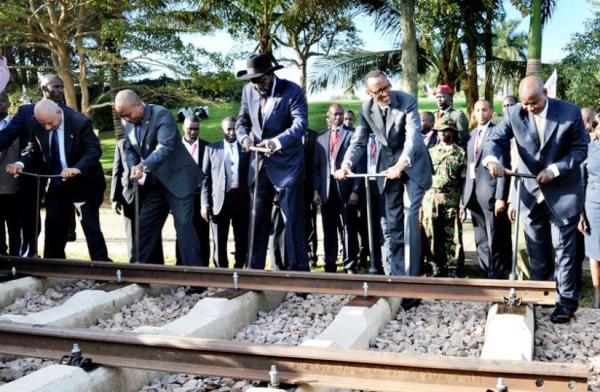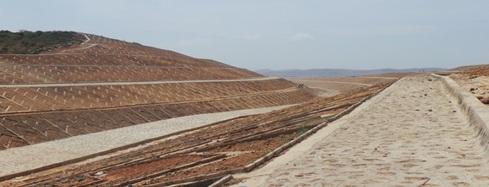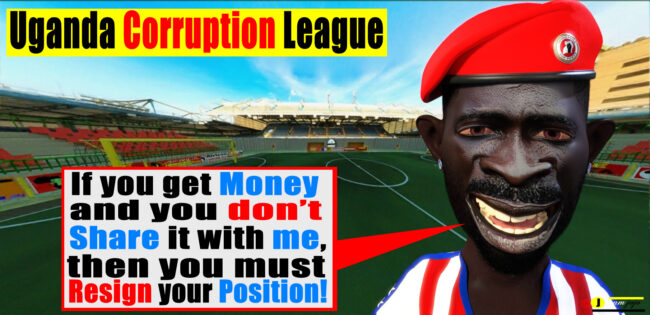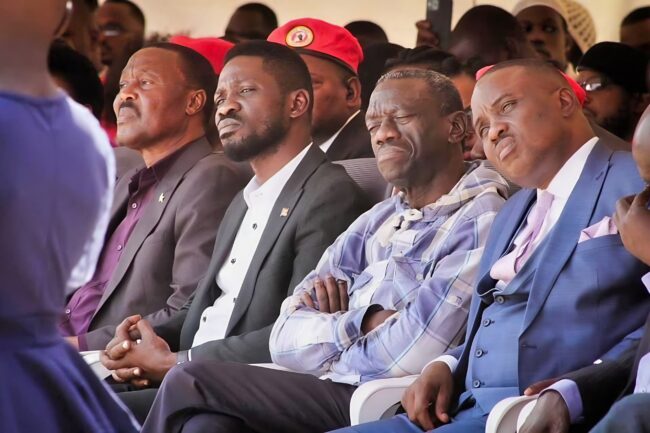Media › Forums › Uganda Today and what is happening in Uganda › Uganda Flip F loping in the East African Community › Uganda infrastructural bottlenecks is hurting economic growth
Uganda infrastructural bottlenecks is hurting economic growth
Around 2010, East African leaders realised that infrastructural bottlenecks were hurting economic growth.
Transporting a cargo from Mombasa to Kampala would take almost a month.
So how would the region export its commodities to the world market or even attract wealthy investors to build industries, transfer skills, add value to locally produced products and create jobs?
Usually, investors go to a country like China or Singapore targeting low costs of production and cheap transport to the sea or ocean.
Their products are usually meant for high-end markets in Europe, North America, Asia and other developed countries due to our limited market size and capacity.
For Uganda to achieve objectives of Uganda Vision 2040 such as a GDP per capita of USD 950o, investment in infrastructure projects is unavoidable.
It is equally important to note the worldwide competition of attracting investors by different countries, hence need for an investment climate that is competitive at global stage.
These investors must be assured of reliable, cheap and adequate transport services to the high end markets. Review of world trade and countries’ economic growth trends depict that participating in global value chains is imperative for growth.
It was on this basis that regional leaders including President Museveni, Rwanda’s Paul Kagame, Uhuru Kenyatta, then Tanzania president Jakaya Kikwete and South Sudan’s Salva Kiir decided to take action.
Under the auspices of Northern Corridor Integration Projects (NCIP), the leaders agreed to develop a seamless high capacity, modern, reliable and safe SGR system across the four countries.
The four NCIP Partner states entered into an SGR Protocol to ensure development of the SGR with the same design standards from Mombasa to Nairobi, Kampala, Kigali and Juba.
 Regional leaders launching SGR projects in Kampala
Regional leaders launching SGR projects in Kampala
In Uganda the SGR will connect to the DR Congo through Kasese District and Arua District, to Rwanda through Mirama Hills in Ntungamo District to South Sudan through Nimule in Amuru District.
Standard Gauge Railway as a back bone of transport infrastructure must provide a transport service for export and import that is comparable to other services in other countries in terms of quality, cost and reliability.
These countries and their neighbors are at different stages of developing their respective railway systems in order to fully participate in international global trade and production.
Although different political agenda have been set especially on the development timelines, the countries are faced with challenges of raising the necessary resources either internally or through external borrowing.
External borrowing is largely dependent on the country’s GDP, Debt to GDP ratio, Revenue to GDP Ratio, and the country’s risk as assessed by international credit rating agencies.
The table below provides some information on the key macro parameters for the respective countries.
| Indicator | Uganda | Kenya | Tanzania | Ethiopia |
| Population (Million) | 38.32 | 46.79 | 52.48 | 99.47 |
| GDP USD(Million) | 25,610 | 69,170 | 46,700 | 69,220 |
| Per Capita Income | 668.3 | 1,478.3 | 889.9 | 695.9 |
| Debt to GDP ratio (%) | 29.6 | 48 | 34.7 | 49.6 |
| Credit Rating* | B | B+ | NA | B |
Source: The World Factbook- Central Intelligence Agency (2015 figures)
* http://www.tradingeconomics.com-list/rating
Positioning
The Standard Gauge Railway Executive Director, Kasingye Kyamugambi told ChimpReports in an exclusive interview at his office in Kampala that Uganda’s strategic geographical positioning puts it at the heart of the East and Central Africa logistics chain and can evacuate its products through the ports of Djibouti, Mombasa and Dar Es Salaam among others.
“However, due to many factors, the port of Mombasa in Kenya and the port of Dar As Salaam in Tanzania are anchor points for two transport routes—the Northern Corridor and the Central Corridor—both crucial for the domestic, regional, and international trade of five Eastern African countries,” he noted.
The Ugandan taxpayer has in recent years expressed alarm at the cost of infrastructural projects valued in billions of dollars borrowed from China.
The Ethiopian-Djibouti line, which opened in October, cost $3.4 Billion for 656km while the Ugandan leg of 273km will cost $2.3bn. Kenya’s 472km stretch will cost $3.4billion.
Why should Uganda’s railways line be more expensive?
During the interview, Kyamugambi said the construction cost of railways “majorly depends on the unique characteristics of the specific project as determined by the design standard, the geology, terrain and hydrology of the project site.”
Kyamugambi further said the Ministry of Works and Transport carried out a study conducted by an international German consultant Gauff Ingenieure who provided the preliminary Engineering and feasibility study for the Malaba-Kampala SGR based on AREMA[1] standards.
“The consultant estimate without locomotives and rolling stock was USD2.4 billion for an electrified railway system and USD2.0 billion for diesel system,” said Kyamugambi.
“The contract price for the Eastern route, exclusive of locomotives and rolling stock and provisional sums is USD2 billion, but based on superior Chinese standards. Uganda’s contract cost for the Eastern Route of USD2.3 billion therefore includes locomotives, rolling stock and provisional sums,” he elaborated
He emphasised that the contract price and negotiations for the EPC turnkey contract for Malaba-Kampala SGR was based on the Employers requirements derived from the Gauff design, and NCIP agreements which were then provided to CHEC – the contractor.
“It is important to note that the railway systems can all be Standard Gauge but designed to different standards e.g. AREMA or Chinese or British or any other standards.”
Kyamugambi said the Northern Corridor countries agreed on China Class 1 Railway standard to ensure a seamless transport network while Tanzania is basing on AREMA standard while Ethiopia is China Class 2 Standard.
The AREMA standard is not a national standard but a standard of an association of some railways in North America while the Chinese Standard is a national standard.
The railways in the four countries are dominantly freight but will have passenger services.
The passenger trains can move at a faster speed compared to freight trains because they are shorter and lighter while the freight trains are longer and heavier.
Kyamugambi said it is important to differentiate the attainable speeds of passenger and freight trains when analyzing the capabilities of the railway systems.
He further pointed out that Chinese Standards, although engineered from AREMA and British standards are much safer, robust, and durable, for example, the “embankments are higher and compacted to a specified densities, the drainage of the embankment is well done in very strong herringbone structures to protect the embankment leading to lower maintenance cost.”
He said it also has lower operation and maintenance requirements.
Over the last 30 years, it is only China that has invested heavily in railways and used them to catapult their economy, justifying the use of their standard.
Kyamugambi said in railway development, the highest cost is in bridges, followed by the earthworks (embankment), truck, stations, electrification, signaling etc.
For example, on Malaba- Kampala, 35 percent of the route is in bridges, 25 percent is in earth works and 10 percent in track, 10 percent stations, 5 percent electrification, 5 percent in signaling and 10 percent others.
Kyamugambi also pointed to terms of obtaining funds from China.
He said to borrow funds from the China EXIM bank, projects must be designed to Chinese Standards, EPC/Turnkey contracting mode, certain environmental standards must be addressed, and the contractor must be Chinese.
Comparison of Major Characteristics of the Malaba-Kampala and Mombasa-Nairobi SGR Projects
| Item | Uganda | Kenya |
| Route Length | 273KM | 472KM |
| Track length | 338KM | 609KM |
| Standard | China Class 1 | China Class 1 |
| System | SGR | SGR |
| Traction | Electric | Diesel |
| welding | Continuous | Jointed |
| Curvatures | 1200/800 | 1200/800 |
| Gradient | 1.2% | 1.2% |
| Trailing Load | 4000/5000 metric tonne | 4000/5000 metric tonne |
| Structure Gauge | Double Stack | Double Stack |
| Signaling | Fully Automatic | Fully Automatic |
| Percentage of Bridges along the route | 8.8 % of the route | 5.9% of the route |
| Super Bridge | 1KM Bridge over river Nile | None |
| Cost per route Km (excluding locomotives) | 7.32m/Km | 7.288M/Km |
| Total costs excluding locomotives | USD204 Billion | USD3.44 Billion |
Kyamugambi said given that the Ugandan System is electric (at additional cost of 0.54m/km), with a major super bridge over the River Nile, and with 53KM in a swamp, Ugandan Malaba-Kampala SGR cost is comparatively lower than the Mombasa-Nairobi SGR section in Kenya.
Furthermore, the cost per route-KM for the Naivasha- Kisumu section is USD13.7M per route- KM due to its unique characteristics including difficult terrain especially in the rift valley region where major bridges will be required.
He said Uganda deliberately took a decision to invest in an electric system due to the lower operation and maintenance requirements (at least 40 percent) compared to the diesel system.
“This will significantly reduce the project life time cost,” he noted.
Another important question on everyone’s mind is why invest all this money, of all places, in the Northern Corridor?
Kyamugambi explained that the Northern Corridor is the “busiest and most important transport route in East and Central Africa, providing a gateway through Kenya to the landlocked economies of Uganda, Rwanda, Burundi and Eastern DR Congo. It also serves Southern Sudan.”
The less busy alternative transport network serving the landlocked Great Lakes Region, said Kyamugambi, is through Tanzania, called the Central Corridor linked to Dar Es Salaam. This uses Tanzania’s Central Line.
Comparison of the Northern and Central Corridors in respect to competitiveness
| ITEM | THE NORTHERN CORRIDOR (Mombasa – Kampala) | THE CENTRAL CORRIDOR (Dar Es Salaam-Morogoro-Tabora-Mwanza-Kampala) |
| Distance
| 1,250KM | 1548KM (1228Km on land and 320km on water) |
| Capacity per day | 8640 containers | 216 containers (due to limitations on the berth, vessels and loading and offloading time). Each wagon ferry/vessel carries 44 containers. |
| Transit time | One day (24hours) | Three days per train (72 hours- optimistic) |
| Restrictions | No restrictions | Some freight like oil products cannot be carried on fresh water |
| Freight Cost
| USD 100 per tonne | USD 124 per tonne |
| Major transshipment | None | Two- At Mwanza and Port bell. Each vessel carries 44 containers. Thus for a train carrying 215 containers will require 5 vessels to evacuate the freight on the lake |
| Capacity of Port | Mombasa port is nearly 3 times bigger than Dar Es Salaam Port | Dar Es Salaam, A third of Mombasa Port |
| Current freight to and through Uganda | 10 Million | 0.5 Million |
| Restriction on goods | No restrictions | Oil products not allowed on fresh water |
| Access to higher end markets | Nearer the Suez Canal the major shipping way | Further from Suez canal and will require dedicated Vessels |
| Expected completion time | Around 2020 -Kenya has commenced construction of the Nairobi-Naivasha Route and is already sourcing for financing for Naivasha-Malaba section. Left with less than 300km to reach the Uganda Boarder) | Around 2030. Tanzania has not commenced development of the 1219km route from Dar Es Salaam to Mwanza. If the route Rusomo, Rwanda and Burundi is done fast, then it may take longer to reach Mwanza |
| Other Infrastructure requirements | Railway infrastructure | Mwanza Port, Bukasa Port, Railway infrastructure and Vessels |
He further pointed out that the Northern route is important because the exports of Kenya to Uganda are estimated at about USD 1bn and Uganda imports about 10m tonnes through the northern Corridor.
Kyamugambi said the issue of cargo capacity will be severely limited by the fact that each wagon vessel carries 44 containers whereas a train can carry up to 216 containers. Therefore, each train can only be offloaded on into five vessels requiring about 15 hours to load and offload the vessels.
For the Malaba-Kampala SGR, up to 40 trains can be operated in a day transporting 8,460 containers.
“If such amount of Cargo was going to be transported on the lake, assuming that a massive of five wagon ferries are purchased, we would require 40 days to evacuate cargo of one train,” said Kyamugambi.
“This means that the route not be viable. This coupled with the fact that oil products cannot be transported on fresh water make the Dar Es Salaam Mwanza Kampala Route can only be a minor alternative to the Mombasa-Kampala Route which should be looked at as the bark born of the railway network to the sea.”
Comparison of Malaba-Kampala and Addis Ababa –Djibouti SGR Projects
| Item | Uganda | Ethiopia |
| Route Length | 273KM | 656KM |
| Track length | 338KM | 765KM |
| Standard | China Class 1 | China Class 2 |
| System | SGR | SGR |
| Traction | Electric | Electric |
| Tonnage per year | Designed for 20-35m tonnes per year | Designed for 10-20m tonnes per year |
| welding | Continuous | Jointed every 300 metres |
| Curvatures | 1200/800 m radius | 800/600 m radius |
| Gradient | 1.2% | 1.85%-2.65% |
| Trailing Load | 4000/5000 tonnes | 3500/4000 tonnes |
| Level Crossings | No level crossings | Several Level crossings |
| Structure Gauge | Double Stack | Single Stack |
| Signaling | Fully Automatic | Semi-automatic |
| Percentage of Bridges | 8.8 % of the route | 3% of the route |
| Super Bridge | 1KM Bridge over river Nile | Maximum bridge 155 metres |
| Earth Fill | 51,620 m3/KM (365% higher than Ethiopia) | 11,110 m3/KM |
| Soil cut | 30,510 m3/KM (116% higher than Ethiopia) | 26,210 m3/KM |
| Higher Embankments | 3634 m3/KM (185% higher than Ethiopia) | 1,961 m3/KM |
| Geo-synthetics | 19,803 m2/KM (966% higher than Ethiopia due to swamps) | 2,050 m2/KM |
| Rock fill | 19,640 m3/KM (161% higher than Ethiopia) | 12,210 m3/KM |
| Cost of cement | USD180/tonne | USD125/tonne |
| Cost of steel | USD680/tonne | USD480/tonne |
| Cost of Diesel | USD0.76/Litre | USD0.62/Litre |
| Royalties on materials and buying out licenses | Land, royalties and licenses | Land only |
| Distance from the coast | 1,170KM | 350KM |
| Cost of financing | 85% borrowed/ 15% domestic | 55% borrowed/ 45% domestic |
| Cost per route Km (excluding locomotives) | USD7.32m/KM | USD5.213M/KM |
| Total costs excluding locomotives | USD2 Billion | USD3.42 Billion |
Kyamugambi said the Ethiopian system was first designed for Class IV and later upgraded to Class II and this resulted in addenda thus increasing the costs.
There are major differences as illustrated above in the terrain, topography and hydrology of the two project sites thus resulting in higher amounts of rock fill, soil cut, embankments, bridges, geo-synthetics that are major cost centres of railway development.
The Class II system looks cheaper at investment stage but will be more expensive in operation and maintenance. Because of the construction standard requirement.
It is important for railways designed for 100 years to look at life cycle costs rather than investment costs.
For the Uganda project one of the major cost centres is the bridge over the River Nile which is 1KM long whereas in Ethiopia the bridge over Awash is significantly narrow.
Kyamugambi said the design of the Ethiopian route was limited by the capacity of Djibouti Port, adding, “if adjustment factors are made for variances in material costs, quantities, risks, cost escalations and transport, the cost in Uganda should be 2.1 higher than the cost in Ethiopia.”
Comparison of Major Characteristics of the of Malaba-Kampala SGR with the Dar Es Salaam-Morogoro SGR Projects
| Item | Uganda | Tanzania |
| Route Length | 273KM | 205KM |
| Track length | 338KM | 300KM |
| Contracting mode** | EPC Turnkey (System approach)** | Design and Build (Element approach)* |
| Standard | China Class 1 | AREMA |
| System | SGR | SGR |
| Traction | Electric | Electric |
| Welding | Continuous | Continuous |
| Curvatures | 1200/800 mR | 1000 mR |
| Gradient | 1.2% | 1.8%/ 2% |
| Level Crossings | No level crossings | No Level crossings |
| Structure Gauge | Double Stack | Single Stack |
| Signaling | Fully Automated | Fully automated |
| Percentage of Bridges | 8.8 % of the route | 1.8% of the route |
| Super Bridge | 1KM Bridge over river Nile | Small bridge over River Ruvu (about 30m wide) |
| Swamps | 53KM | No major swamp |
| Formation width | 7.7 metres | 6.6 metres |
| Minimum embankment height | 2.5 metres | 0.64 metres |
| Cost of cement (Normal grade) | USD180/tonne | USD110/tonne |
| Cost of steel | USD680/tonne | USD680/tonne |
| Transportation capacity | 22 million tonnes per annum | 18 million tonnes per annum |
| Royalties on materials and buying out licenses | Land, royalties and licenses | Only pay for land |
| Distance from the coast | 1,170KM | 100KM |
| Cost of financing | 85% borrowed/ 15% domestic | 50% borrowed/ 50% domestic |
| Cost per route Km (excluding locomotives) | USD7.3m/KM | USD5M/KM |
| Total costs excluding locomotives | USD2.04 Billion | USD1.029 Billion |
The major differences between the Chinese standard and the AREMA standard are: The formation width (top width of embankment) is 7.7 meters for Chinese standards while AREMA is 6.6 meters.

SGR records indicate the height, design and construction of the embankment which is limited to a minimum of 2.5 meters high for Chinese standard and 0.64 meters for AREMA.
These high embankments in the Chinese standards require slope protection.
The Chinese classification requires the herringbone concrete structure for protection of embankments and concrete masonry for higher embankments of 6 meters while this is not a requirement for the AREMA standards require only benching and grassing.
 Concrete structures is higher in Chinese standards than the AREMA standards
Concrete structures is higher in Chinese standards than the AREMA standards
Kyamugambi said the safety factor in the concrete structures is higher in Chinese standards than the AREMA standards.
“The utilisation of engineering materials especially the geo-synthetics (geogrid and geotextile) for tightening the soft ground, the backfilling material and soft ground treatments are different in both Chinese and AREMA standards,” he observed.
The general design and construction differences in the two standards would therefore make a railway designed and constructed to Chinese standards (which is superior) more expensive than the one designed and constructed to AREMA standards.
Kyamugambi said both the Northern and the central corridor are important for the land locked east African countries but the northern corridor is a more viable route for Uganda as it has a higher potential to spur growth in the country and should be developed fast.





